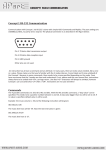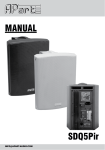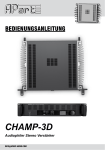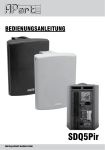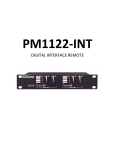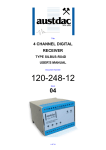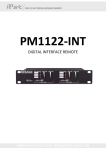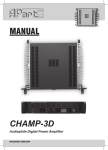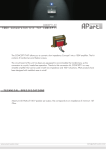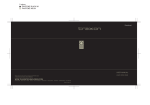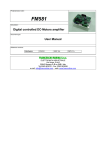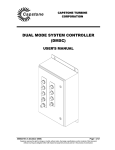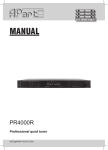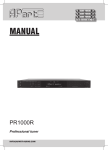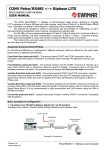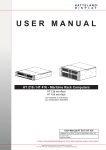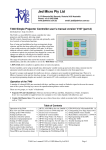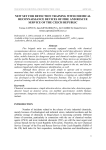Download Manual CM6ST
Transcript
CONCEPT1 RS232 COMMUNICATION Concept 1 RS-232 Communication Communication with Concept 1 via RS-232 is done with simple ASCII Commands and Replies. The port settings are 19200Baud, 8bits, no parity and 1 stop bit. The physical connection is as described in the figure below: Pin 2: TX data: data transmission output Pin 3: RX data: data reception input Pin 5: GND: ground Other pins are not used. An instruction has at least a command and an attribute. In many cases, there are extra values needed, like a zone or a value. Please make sure that you’re familiar with the 3 modes (stereo, 2 zone linked and 2 zone unlinked) of the Concept 1 because in some commands, there needs to be a zone specified depending on the mode. From here we assume that the 3 modes are clear and understood. If not, please read the user manual first. Instructions always have to be ended with <CR>, carriage return. Line feed <LF> characters will always be omitted, however Concept 1 can use (and echo) <LF> after a <CR>. Instructions are not case sensitive! Commands The 4 possible commands are: SET, GET, INC and DEC. With the INC and DEC command, a “step value” can be specified. This needs to be a positive number between 1 and 10. A step value bigger than 10, will be set to 10. If no value is specified, default value 1 will be used. Example: the music volume is -50 and the following instruction will be given: INC MSCLVL<CR> The music level now will be -49. Now the next instruction is given: DEC MSCLVL 8<CR> The music level now is -57. WWW.APART-AUDIO.COM [email protected] CONCEPT1 RS232 COMMUNICATION Overview of Attributes Attribute MULTIZONE ZONELINK MSCLVL MICLVL MAXMSCLVL MAXMICLVL SELECT EQBASS EQTREB STANDBY AUTOLD PAGACT IPGAIN ECHO LF BS HEADER VALFB INFO SOURCENAME SERIAL HWVRSN SWVRSN RESTORE Description Commands Zone Value* Multi Zone Zone Link GET, SET No Binary Music Level Microphone Level Maximum Music Level Maximum Mic. Level GET, SET, INC, DEC 2 GET, SET No A, B, C or D Equalizer Bass Equalizer Treble GET, SET No No -14 to 14 Standby GET, SET No Binary Auto Loudness Paging Active Input Gain GET, SET Source Selection 1 OFF (-80) -79 to 0 GET, SET No 2 No -20 to 14 Echo Line feed Back Space Header GET, SET No Binary Value Feedback Info GET, SET GET No Binary / Source Name GET, SET No <String> Serial Number Hardware Version Number Software Version Number GET No / Restore Factory Settings SET No Binary Binary * The column “Value” describes what range of values need to be given with the SET command Value “Binary” can be OFF / ON or 0 / 1 Mode The mode of Concept 1 is determined by MULTIZONE and ZONELINK. If MULTIZONE is OFF, the amplifier is working in stereo mode. If MULTIZONE is ON, the amplifier will work in 2 zone mode. If ZONELINK is ON, the music level of zone 1 and zone 2 are linked. Otherwise, when ZONELINK is OFF, the 2 zones have a separate volume setting. Since these 2 commands change the behavior of the amplifier, it’s recommended only to change them when the amplifier is not in action (no music present, volume at minimum). If the amplifier needs to be configured in another mode, these are the first settings that need to be changed WWW.APART-AUDIO.COM [email protected] CONCEPT1 RS232 COMMUNICATION Operating Settings MSCLVL is the music level. It can be OFF or a value between -79 and 0. If set at -80, it will be ”OFF”. If both MULTIZONE and ZONELINK are ON, the corresponding zone needs to be specified. MICLVL is the microphone level. It can be OFF or a value between -79 and 0. If set at -80, it will be ”OFF”. If MULTIZONE is ON, the corresponding zone needs to be specified. MAXMSCLVL is the maximum music level. If the music level is adjusted above the maximum, it will be changed to the maximum value. In case both MULTIZONE and ZONELINK are ON, there still are 2 different values possible for zone 1 and zone 2. The difference between those 2 levels will determine the offset between the volumes of both zones. The maximum difference in this mode is 40. Example: SET MAXMSCLVL ZONE1 -16<CR> SET MAXMSCLVL ZONE2 -10<CR> Now, the volume can be adjusted between OFF and -10. The level in zone 1 will always be 6 dB lower than the level in zone 2. MAXMICLVL is the maximum microphone level. If the microphone level is adjusted above the maximum, it will be changed to the maximum value. SELECT is the source selection. The source selection in both zones is always the same, so it’s never needed to specify the zone Equalizer Also the equalizer settings are the same for both zones. EQBASS sets the level of the bass. EQTREB sets the level of the treble. The value must be between -14 and 14 in steps of 2. If a different value is used, it will get changed to the closest match. Configuration Settings AUTOLD is Auto Loudness and this is only active in Stereo mode. It will adjust the equalizer depending of the volume setting. If the auto loudness is on, the sound will still be more “rich” at low levels. PAGACT is paging active. If set on, the microphone will only be on when there is a contact between pin A or B and the ground of the connector at the backside of the amplifier (see user manual). In that case, the music will be muted as well. The Concept 1 will also send ”PAGING (ZONEx) ON/OFF<CR>” when the contacts are closed/opened so the user can know the status. IPGAIN is input gain. Each source input has its own gain setting so the source (A, B, C or D) needs to be specified. The value can be between -20 and 14 in steps of 2. If an invalid value is used or no source is specified, “ERROR: Value Invalid!<CR>” will be replied. Otherwise, the reply will be “Command Exicuted!<CR>” ZONESPLIT is only used in MULTIZONE mode. Default, the zone split value is off, which means that left and right of the sources will be mono summed in MULTIZONE mode. Some users would like to have a different music in each zone by plugging different sources for left and right. By setting ZONESPLIT on, the left input will be sent to zone1 and right input to zone 2, like in stereo mode. This way, it’s possible to have different music in each zone but please note that the source select will always impact both zones. The ZONESPLIT feature is implemented starting from V1.0.2 WWW.APART-AUDIO.COM [email protected] CONCEPT1 RS232 COMMUNICATION RS-232 Settings All RS-232 settings are binary values, they can be ON or OFF. If ECHO is on, all received characters are echoed back. This can be handy when programs like hyperterminal are used. LF is Line Feed. Line feed is an ASCII character (0x0A) which is sometimes used to let the cursor jump to the next line. Concept 1 always omits the line feed character. However, when LF is on, there will be put <LF> character behind each <CR> character. This is both the case for echoing as for messages send by Concept 1. Please take a look to following example: in both cases, the user sends the following string: “get msclvl<CR>”. With ECHO on and LF off, this will be returned by Concept1: “get msclvl<CR>” “MSCLVL -16<CR>” In case both ECHO and LF are on, it will be like this: “get msclvl<CR><LF>” “MSCLVL -16<CR><LF>” BS is Back Space. This is also an ASCII character. In case BS and ECHO is on, Concept 1 will reply <BS><SP><BS> each time when a <BS> is received. <SP> is the space character. This setting is only intended to have a “nice” text when used with programs like Hyperterminal. With HEADER on, each string, both incoming as outgoing, has to start with “>” (ASCII character 0x3E) as header of the string. This function works only when ECHO is OFF! Please note that for the first replies after start up, this function will not work correctly. The reason for this is that the settings are loaded later. Anyway, this shouldn’t be a problem. If ECHO and LF are put off and HEADER is put on, each string will start with “>” (ASCII character 0x3E) and each string will end with <CR> (ASCII character 0x0D). This can help in making the string handling easier. Please don’t forget that also instructions will have to begin with “> “ in this case! Example (with MULTIZONE and VALFB ON): Instruction: >SET MICLVL ZONE1 -35<CR> Reply: >MICLVL ZONE1 -35<CR> WWW.APART-AUDIO.COM [email protected] CONCEPT1 RS232 COMMUNICATION Status Update VALFB stands for Value Feed Back. When this setting is on, all value changes are sent “autonomously” by Concept 1. This way it’s easy to keep the status synced. Default, VALFB is on. IPGAIN and SOURCENAME are NOT sent when they are modified. INFO can only be used with the GET command. The GET INFO instruction is replied with the current status of most variables. It will only work when VALFB is on. IPGAIN and SOURCENAME is not sent after the GET INFO instruction but their status can also be requested with the GET command. Below is an example of a reply after a GET INFO instruction in stereo mode. The <CR> characters at the end of the line are not shown: PAGING OFF MULTIZONE OFF PAGACT ON AUTOLD ON SELECT A MSCLVL OFF MICLVL OFF MAXMSCLVL 0 MAXMICLVL 0 EQBASS 0 EQTREB 0 Source Name With SOURCENAME, it’s possible to change or read the source name that’s shown on the display of the Concept 1. There always has to be a source (A, B, C or D) specified. The source name string itself is case sensitive and may contain space characters. Example: Instruction: get sourcename a<CR> Reply: Source A<CR> Instruction: set sourcename a BGM3000<CR> Reply: Command Executed!<CR> Instruction: get sourcename a<CR> Reply: BGM3000<CR> Version information The following attributes will only work with the GET command: SERIAL will return the serial number, a 4 digit hex number. In case it’s not programmed, it will return “Not Yet Implemented!<CR>”. HWVRSN will return the hardware version number SWVRSN will return the hardware version number WWW.APART-AUDIO.COM [email protected] CONCEPT1 RS232 COMMUNICATION Restore Factory Settings The factory settings can be restored with the following instruction: “SET RESTORE ON<CR>”. The Concept1 will reply with “Please Cycle Power!<CR>”, the output will be muted and the display will show “RESET”. The user must power off and power on the amplifier. During power on, the factory settings will be restored. Standby The amplifier can be set in Standby mode with the (optional) IR remote control or with the SET STANDBY ON instruction. Leaving Standby mode can also be done with IR remote controller or the SET STANDBY OFF instruction. If an RS-232 instruction is given when the amplifier is in Standby mode or during power on and the amplifier is not ready, it will answer with “STANDBY ON”. Please wait until the amplifier is operational. Power down During power down, all settings are stored in the memory of Concept1. After this, a string “POWER DOWN!<CR>” will be send. Depending on how much variables that need to be stored, possible, there is not enough time to send this complete string. Errors The following error strings may be sent by Concept1: ERROR: Command Unknown!<CR> character. : Wrong spelling of command or command started with Back Space ERROR: Unknown Attribute! <CR> : Wrong spelling of attribute. ERROR: No Header! <CR> with header. See “RS-232 Settings”. : When HEADER is on and ECHO is off, each instruction must be started ERROR: Unknown Instruction! <CR> SET SERIAL 0001<CR> : A command was used with an attribute that does not support this. E.g. ERROR: Value Invalid! <CR> : A value was out of range or illegal. ERROR: Zone Invalid! <CR> : No valid zone was specified. Valid zone names are ZONE1 and ZONE2, without space between ZONE and its number. ERROR: AMPLIFIER PROTECT! <CR> : See user manual (or appendix) ERROR: OVER TEMPERATURE! <CR> : See user manual Appendix The instructions SET IPGAIN … and SET SOURCENAME … will write a value to the internal memory of the Concept1. When these instructions are given, please wait for the reply or put a delay of at least 100ms after this instruction. The amplifiers with Hardware Version number ACPT 1V04 could possible send “ERROR: AMPLIFIER PROTECT!<CR>” when they are powered off. This is because the sense circuit of the amplifier reacts very fast. This doesn’t mean there is something wrong with the amplifier. WWW.APART-AUDIO.COM [email protected]






